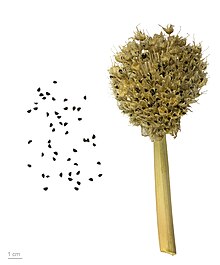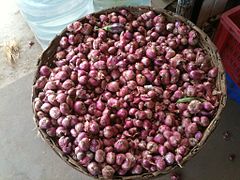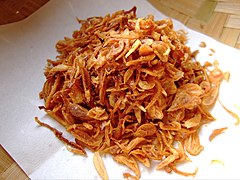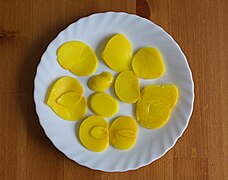Shallot
| Shallot | |
|---|---|
 Sliced and whole red shallots | |
| Species | Allium cepa(see text) |
| Cultivar group | Aggregatum Group |
Theshallotis acultivar groupof theonion.Until 2010, the (French red) shallot was classified as a separate species,Allium ascalonicum.The taxon wassynonymizedwithAllium cepa(the common onion) in 2010, as the difference was too small to justify a separate species.[1][2]
As part of the onion genusAllium,its close relatives includegarlic,scallions,leeks,chives,[3]and theChinese onion.[4]
Etymology and names[edit]
The namesscallionandshallotare derived from theOld Frencheschalotte,by way ofeschaloigne,from theLatinAscalōnia caepaor Ascalonian onion, aAscalōnia caepaor Ascalonian onion, a namesake of the ancient city ofAscalon.[5][6][7]
The termshallotis usually applied to the French red shallot (Allium cepavar.aggregatum,or theA. cepaAggregatum Group). It is also used for thePersian shallotormusir(A. stipitatum) from theZagros MountainsinIranandIraq,and the French gray shallot (Allium oschaninii) which is also known asgriselleor "true shallot";[8]it grows wild fromCentraltoSouthwest Asia.The nameshallotis also used for ascallioninNew South Wales,Australia[9]and among English-speaking people in Quebec while the termFrench shallotrefers to the plant referred to on this page.[10]In most English-speaking nations, the name is pronounced with the emphasis on the last syllable in common with the French pronunciation,sha-lot,while the emphasis is commonly made on the first syllable,shall-ət,in the United States.[citation needed]
The termeschalot,derived from theFrenchwordéchalote,can also be used to refer to the shallot.[11]
Description and cultivation[edit]



Likegarlic,shallots are formed in clusters ofoffsetswith a head composed of multiple cloves. The skin colour of shallots can vary from golden brown to gray to rose red, and their off-white flesh is usually tinged with green or magenta.[12]
Shallots are extensively cultivated for culinary uses, propagated by offsets. In some regions ( "long-season areas" ), the offsets are usually planted in autumn (September or October in theNorthern Hemisphere).[13]In some other regions, the suggested planting time for the principal crop is early spring (typically in February or the beginning of March in the Northern Hemisphere).[14]
In planting, the tops of thebulbsshould be kept a little above ground, and thesoilsurrounding the bulbs is often drawn away when the roots have taken hold. They come to maturity in summer, although fresh shallots can now be found year-round in supermarkets. Shallots should not be planted on ground recentlymanured.Shallots suffer damage fromleek mothlarvae, which mine into the leaves or bulbs of the plant.[15]
Nutrition[edit]
A raw shallot is 80% water, 17%carbohydrates,2.5%proteinand contains negligiblefat(table). In a reference amount of 100 grams (3.5 oz), raw shallot supplies 72caloriesand is a rich source ofvitamin B6(27% of theDaily Value,DV), while providing moderate amounts ofmanganese(14% DV) andvitamin C(10% DV) (table). No othermicronutrientsare in significant content.
| Nutritional value per 100 g (3.5 oz) | |
|---|---|
| Energy | 301 kJ (72 kcal) |
16.8 g | |
| Sugars | 7.87 g |
| Dietary fiber | 3.2 g |
0.1 g | |
2.5 g | |
| Vitamins | Quantity %DV† |
| Thiamine (B1) | 5% 0.06 mg |
| Riboflavin (B2) | 2% 0.02 mg |
| Niacin (B3) | 1% 0.2 mg |
| Pantothenic acid (B5) | 6% 0.29 mg |
| Vitamin B6 | 20% 0.345 mg |
| Folate (B9) | 9% 34 μg |
| Vitamin C | 9% 8 mg |
| Vitamin E | 0% 0.04 mg |
| Vitamin K | 1% 0.8 μg |
| Minerals | Quantity %DV† |
| Calcium | 3% 37 mg |
| Iron | 7% 1.2 mg |
| Magnesium | 5% 21 mg |
| Manganese | 13% 0.292 mg |
| Phosphorus | 5% 60 mg |
| Potassium | 11% 334 mg |
| Zinc | 4% 0.4 mg |
| Other constituents | Quantity |
| Water | 80 g |
| †Percentages estimated usingUS recommendationsfor adults,[16]except for potassium, which is estimated based on expert recommendation fromthe National Academies.[17] | |
Uses[edit]
Culinary[edit]
Shallots are used in cooking. They may bepickled.Finely-sliceddeep-friedshallots are used as acondimentinAsian cuisine,often served withporridge.Shallots taste similar to other cultivars of the commononion,but have a milder flavor.[18]Like onions, when sliced, raw shallots release substances thatirritate the human eye,resulting in production oftears.
Fresh shallots can be stored in a cool, dry area (0 to 4 °C, 32 to 40 °F, 60 to 70% RH) for six months or longer.[19]Chopped, dried shallots are available.[20]
Europe[edit]
In Europe, the Pikant, Atlas, and Ed's Red types of shallots are the most common.[citation needed]
Asia[edit]
Shallots are the traditional choice for many dishes in Sri Lankan cuisine, includingpol sambola,lunu mirisand many meat, fish and vegetable dishes.
In mostIndian cuisines,the distinction between onions and shallots is weak; larger varieties of shallot are sometimes confused with small red onions and used interchangeably. Indeed, most parts of India use the regional name for onion interchangeably with shallot (Maharashtra, for instance, where both are calledkanda). The southern regions of India distinguish shallots from onions in recipes more often, especially the much loved tiny varieties (about the width of a finger); these are widely used in curries and different types ofsambar,alentil-based dish. Shallots pickled in red vinegar are common in many Indian restaurants, served along with sauces andpapadon the condiments tray. They are also used[clarification needed]as a home remedy for sore throats, mixed with jaggery or sugar. In Nepal, shallots are used as one of the ingredients for makingmomo.
In Kashmir shallots are widely used in preparation of Wazwan Kashmiri cuisine, as they add distinct flavor and prevent curry from becoming black, which is common with onions.
InIranshallots are used in various ways, the most common being grated shallot mixed into dense yogurt, a combination served in almost every restaurant when one orders grills or kebabs. Shallots are also used to make different types oftorshi(ترشی), a sour Iranian side dish consisting of a variety of vegetables under vinegar, eaten with main dishes in small quantities. Shallot is also pickled—calledshour(شور) in Persian—along with other vegetables to be served astorshi.
InSoutheast Asian cuisines,such as those ofIndonesia,Vietnam,Thailand,Cambodia,Malaysia,Philippines,SingaporeandBrunei,both shallots and garlic are often used as elementary spices. Raw shallots can also accompany cucumbers when pickled in mild vinegar solution. They are also often chopped finely, then fried until golden brown, resulting in tiny crispy shallot chips calledbawang goreng(fried shallots) in Indonesian, which can be bought ready-made from groceries and supermarkets. Shallots enhance the flavor of many Southeast Asian dishes, such asfried ricevariants. They are also often present in noodle and slaw dishes.[21]Crispy shallot chips are also used in southern Chinese cuisine. In Indonesia, shallots are sometimes pickled and added to several traditional foods; the pickles' sourness is thought to increase the appetite. In the southernPhilippines,shallot bulbs and leaves are used to make the popular spicyMaranaocondiment calledpalapa,which is used in the dishPiaparan.
The tubular green leaves of the plant can also be eaten and are very similar to the leaves of spring onions and chives.
Gallery[edit]
-
Shallots for sale in India
-
Shallots being chopped forsatay
-
Sliced shallots forbawang gorengin Indonesia
-
Bawang goreng,consisting of crispy deep-fried shallots, is a popular garnish inIndonesia.
-
Pickled shallots
See also[edit]
References[edit]
- ^"Allium ascalonicum".Germplasm Resources Information Network.Agricultural Research Service,United States Department of Agriculture.Retrieved2010-08-20.
- ^Fritsch, R. M.; N. Friesen (2002). "Chapter 1: Evolution, Domestication, and Taxonomy". In H. D. Rabinowitch and L. Currah (ed.).Allium Crop Science: Recent Advances.Wallingford, UK: CABI Publishing. p.21.ISBN0-85199-510-1.
- ^Block, E. (2010).Garlic and Other Alliums: The Lore and the Science.Royal Society of Chemistry.ISBN978-0-85404-190-9.
- ^"AllergyNet — Allergy Advisor Find".Allallergy.net. Archived fromthe originalon 15 June 2010.Retrieved14 April2010.
- ^"scallion",atBalashon - Hebrew Language Detective,5 July 2006. Accessed 28 Feb 2024.
- ^"shallot".New Oxford American Dictionary(Second ed.). Oxford University Press. 2005.
- ^shallot.CollinsDictionary. Collins English Dictionary - Complete & Unabridged 11th Edition. Retrieved 30 September 2012.
- ^Green, Aliza (2004),Field Guide to Produce: How to Identify, Select, and Prepare Virtually Every Fruit and Vegetable at the Market,Quirk Books, p. 256,ISBN978-1-931686-80-8
- ^"Spring onions v shallots".22 January 2013.RetrievedMay 14,2019.
- ^"Montreal public market site".Montreal public markets. Archived fromthe originalon June 30, 2017.RetrievedAugust 28,2014.
- ^"Dictionary: eschalot".Merriam-Webster, Incorporated.RetrievedDecember 4,2013.
- ^Nolte, Kurt."Shallot.pdf"(PDF).College of Agriculture and Life Sciences | The University of Arizona.Archived(PDF)from the original on January 22, 2021.RetrievedMay 8,2021.
- ^Hunt, Marjorie B. and Bortz, Brenda (1986),High-Yield Gardening,Pennsylvania: Rodale Press,ISBN0-87857-599-5
{{citation}}:CS1 maint: multiple names: authors list (link) - ^Seabrook, Peter (1976),Complete Vegetable Gardener,London: Cassell,ISBN978-0-304-29738-2
- ^Landry, Jean-François (2007)."Taxonomic review of the leek moth genus Acrolepiopsis (Lepidoptera: Acrolepiidae) in North America".The Canadian Entomologist.139(3): 319–353.doi:10.4039/n06-098.S2CID86748199.
- ^United States Food and Drug Administration(2024)."Daily Value on the Nutrition and Supplement Facts Labels".FDA.Archivedfrom the original on 2024-03-27.Retrieved2024-03-28.
- ^National Academies of Sciences, Engineering, and Medicine; Health and Medicine Division; Food and Nutrition Board; Committee to Review the Dietary Reference Intakes for Sodium and Potassium (2019). Oria, Maria; Harrison, Meghan; Stallings, Virginia A. (eds.).Dietary Reference Intakes for Sodium and Potassium.The National Academies Collection: Reports funded by National Institutes of Health. Washington, DC: National Academies Press (US).ISBN978-0-309-48834-1.PMID30844154.Archivedfrom the original on 2024-05-09.Retrieved2024-06-21.
- ^"Kitchen Dictionary: shallot".Scripps Networks.RetrievedDecember 4,2013.
- ^"Onions, Garlic, and Shallots".Virginia Cooperative Extension. May 1, 2009. Archived fromthe originalon September 1, 1999.RetrievedMarch 13,2013.
- ^"Shallots, Freeze Dried".McCormick & Co. Inc. 2011.RetrievedMarch 13,2013.
- ^Lopez-Alt, J. Kenji (May 23, 2022)."What Store-Bought Fried Shallots Can Do for You".New York Times.RetrievedJanuary 12,2024.





